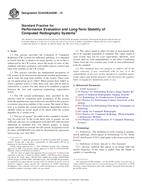We need your consent to use the individual data so that you can see information about your interests, among other things. Click "OK" to give your consent.
ASTM E2445/E2445M-14
Standard Practice for Performance Evaluation and Long-Term Stability of Computed Radiography Systems
STANDARD published on 1.10.2014
The information about the standard:
Designation standards: ASTM E2445/E2445M-14
Note: WITHDRAWN
Publication date standards: 1.10.2014
SKU: NS-45315
The number of pages: 21
Approximate weight : 63 g (0.14 lbs)
Country: American technical standard
Category: Technical standards ASTM
The category - similar standards:
Annotation of standard text ASTM E2445/E2445M-14 :
Keywords:
basic spatial resolution, burn-in, central beam alignment, contrast sensitivity, CR phantom, EPS, erasure, geometric distortion, imaging plate artifacts, imaging plate fading, laser beam scan line integrity, laser jitter, PMT non-linearity, scan column dropout, scanner slippage, spatial linearity, ICS Number Code 19.100 (Non-destructive testing)
Additional information
| Significance and Use | ||||||||||||||
|
4.1 This practice is intended to be used by the NDT using organization to measure baseline performance of the CR system and to monitor its performance throughout its service as an NDT imaging system. For purposes of this document, the CR System is defined as: 4.1.1 Storage phosphor imaging plate (IP) type and manufacturer, 4.1.2 Read out unit (scanner or reader) manufacturer and model, including applicable scanner settings (e.g., sampling resolution, PMT gain, pixel value (PV) look up table, etc.), 4.1.3 Image acquisition and processing software, and 4.1.4 Image display monitor. 4.2 It is to be understood that the CR system has already been selected and purchased by the user from a manufacturer based on the inspection needs at hand. The user shall accept the CR scanner based on manufacturer’s results of Practice E2446 on the specific CR scanner as provided in a data sheet for that serialized CR scanner or other acceptance test agreed to between the user and manufacturer (not covered in this practice). This practice is not intended to be used as an “acceptance test” of the CR system, but rather to establish a performance baseline that will enable tracking while in-service. 4.3 Although many of the properties listed in this standard have similar metrics to those found in E2446, data collection methods are not identical, and comparisons among values acquired with each standard should not be made. 4.4 This practice defines the tests to be performed and required intervals. Also defined are the methods of tabulating results that CR users will complete following the baseline of the CR system. These tests will also be performed periodically at the stated required intervals to evaluate the CR system to determine if the system remains within acceptable operational limits as established in this practice. 4.5 There are several factors that affect the image quality of a CR image. Factors which are dependent on the CR system performance include basic spatial resolution, relative contrast, and signal-to-noise ratio (SNR) which yield the contrast sensitivity (CS), and Equivalent Penetrameter Sensitivity (EPS). There are several additional factors that are dependent on how well the CR system is functioning (i.e., resulting from normal wear and tear, inadequate maintenance, improper setup/calibration, etc.), such as slippage, laser jitter, geometric distortion, etc. Other factors which are related to the specific applications (e.g., geometric unsharpness, scatter, etc.) are not evaluated in these tests. |
||||||||||||||
| 1. Scope | ||||||||||||||
|
1.1 This practice describes the evaluation of Computed Radiology (CR) systems for industrial radiology. It is intended to ensure that the evaluation of image quality, as far as this is influenced by the CR system, meets the needs of users of this standard, and their customers, and enables process control and long-term stability of the CR system. 1.2 This practice specifies the fundamental parameters of CR systems to be measured to determine baseline performance, and to track the long term stability of the system. These tests are for applications up to 320kV. When greater than 320kV or when a gamma source is used, these tests may still be used to characterize a system, but may need to be modified as agreed between the user and cognizant engineering organization (CEO). 1.3 The CR system performance tests specified in this practice shall be completed upon acceptance of the system from the manufacturer and at intervals specified in this practice to monitor long term stability of the system. The intent of these tests is to monitor the system performance degradation and to identify when an action needs to be taken when the system degrades by a certain level. 1.4 The use of gauges2 provided in this standard is mandatory for each test. In the event these tests or gauges are not sufficient, the user, in coordination with the CEO shall develop additional or modified tests, test objects, gauges, or image quality indicators to evaluate the CR system. Acceptance levels for these ALTERNATE tests shall be determined by agreement between the user and CEO. 1.5 The values stated in either SI units or inch-pound units are to be regarded separately as standard. The values stated in each system may not be exact equivalents; therefore, each system shall be used independently of the other. Combining values from the two systems may result in non-conformance with the standard. 1.6 This standard does not purport to address all of the safety concerns, if any, associated with its use. It is the responsibility of the user of this standard to establish appropriate safety and health practices and determine the applicability of regulatory limitations prior to use. |
||||||||||||||
| 2. Referenced Documents | ||||||||||||||
|
We recommend:
Updating of laws
Do you want to be sure about the validity of used regulations?
We offer you a solution so that you could use valid and updated legislative regulations.
Would you like to get more information? Look at this page.




 Cookies
Cookies
